weight AUDI S3 2016 Owners Manual
[x] Cancel search | Manufacturer: AUDI, Model Year: 2016, Model line: S3, Model: AUDI S3 2016Pages: 328, PDF Size: 81.78 MB
Page 65 of 328
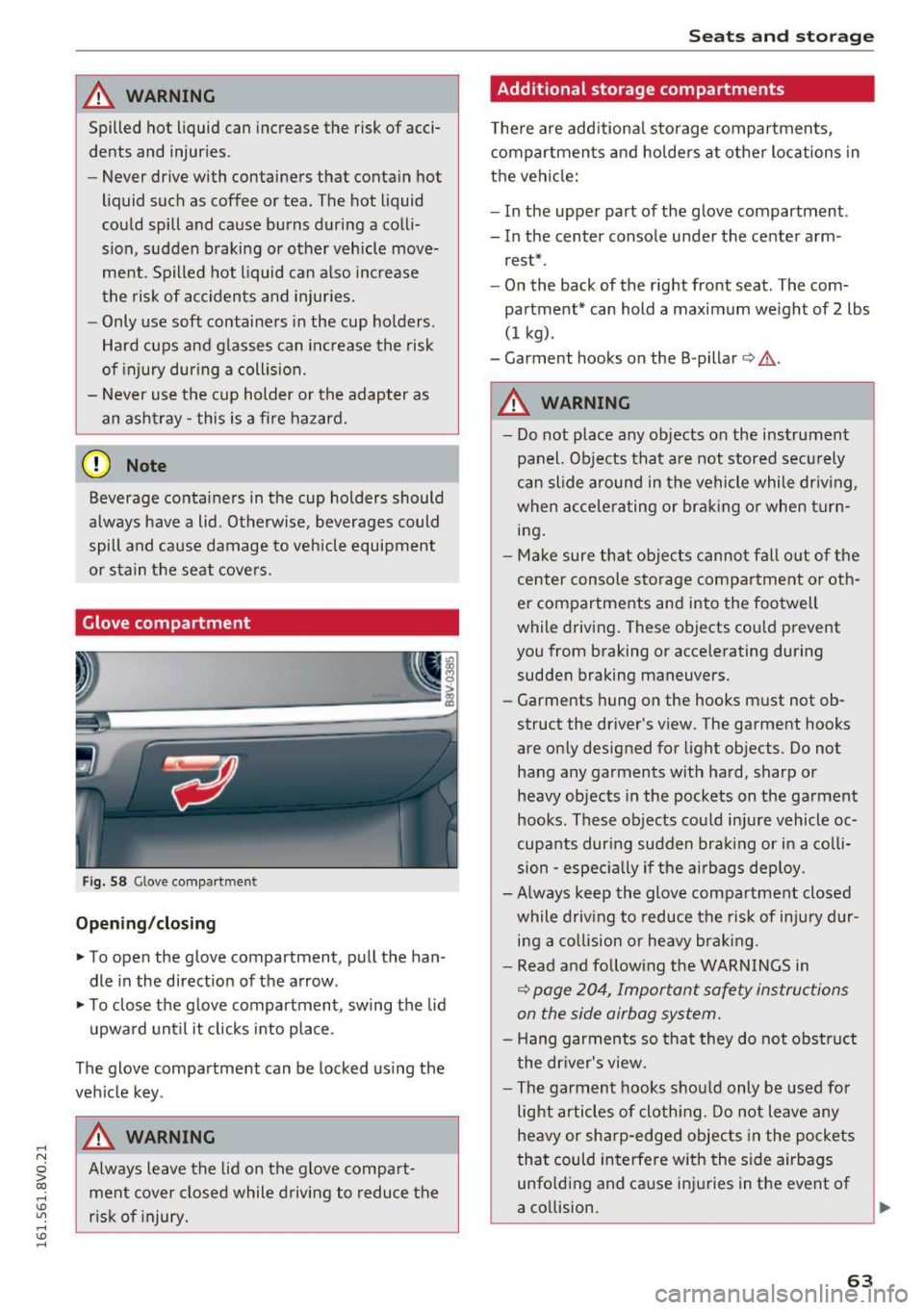
.... N
0 > CX)
.... I.Cl U"I
.... I.Cl ....
A WARNING
Spilled hot liquid can increase the risk of acci
dents and injuries.
- Never drive with containers that contain hot
liquid such as coffee or tea. The hot liquid
could spill and cause burns during a colli
sion, sudden braking or other vehicle move
ment. Spilled hot liquid can also increase
the risk of accidents and injuries.
- Only use soft containers in the cup holders .
Hard cups and glasses can increase the risk
of injury during a collision.
- Never use the cup holder or the adapter as
an ashtray - this is a fire hazard.
(D Note
Beverage containers in the cup holders should
always have a lid . Otherwise, beverages could
spill and cause damage to vehicle equipment
or stain the seat covers.
Glove compartment
Fig. 58 Glove compartmen t
Opening/closing
.. To open the glove compartment, pull the han
dle in the direction of the arrow.
.. To close the glove compartment , swing the lid
upward until it clicks into place .
The glove compartment can be locked using the
vehicle key .
A WARNING
Always leave the lid on the glove compart
ment cover closed while driving to reduce the
risk of injury.
Seats and storage
Additional storage compartments
There are additional storage compartments,
compartments and holders at other locations in
the vehicle:
- In the upper part of the glove compartment.
- In the center console under the center arm -
rest* .
- On the back of the right front seat . The com
partment* can hold a maximum weight of 2 lbs
(1 kg) .
- Garment hooks on the B -pillar
c:> ,& .
A WARNING ,~ -- Do not place any objects on the instrument
panel. Objects that are not stored securely
can slide around in the vehicle while driving ,
when accelerating or braking or when turn
ing.
- Make sure that objects cannot fall out of the
center console storage compartment or oth
er compartments and into the footwell
while driving. These objects could prevent
you from braking or accelerating during
sudden braking maneuvers.
- Garments hung on the hooks must not ob
struct the driver's view . The garment hooks
are only designed for light objects. Do not hang any garments with hard, sharp or
heavy objects in the pockets on the garment
hooks . These objects could injure vehicle oc
cupants during sudden braking or in a colli
sion -especially if the airbags deploy .
-Always keep the glove compartment closed
while driving to reduce the risk of injury dur
ing a collision or heavy braking .
- Read and following the WARNINGS in
¢ page 204, Important safety instructions
on the side airbag system.
- Hang garments so that they do not obstruct
the driver's view .
- The garment hooks should only be used for
light articles of clothing. Do not leave any
heavy or sharp-edged objects in the pockets
that could interfere with the side airbags
unfolding and cause injuries in the event of
a collision.
63
Page 69 of 328
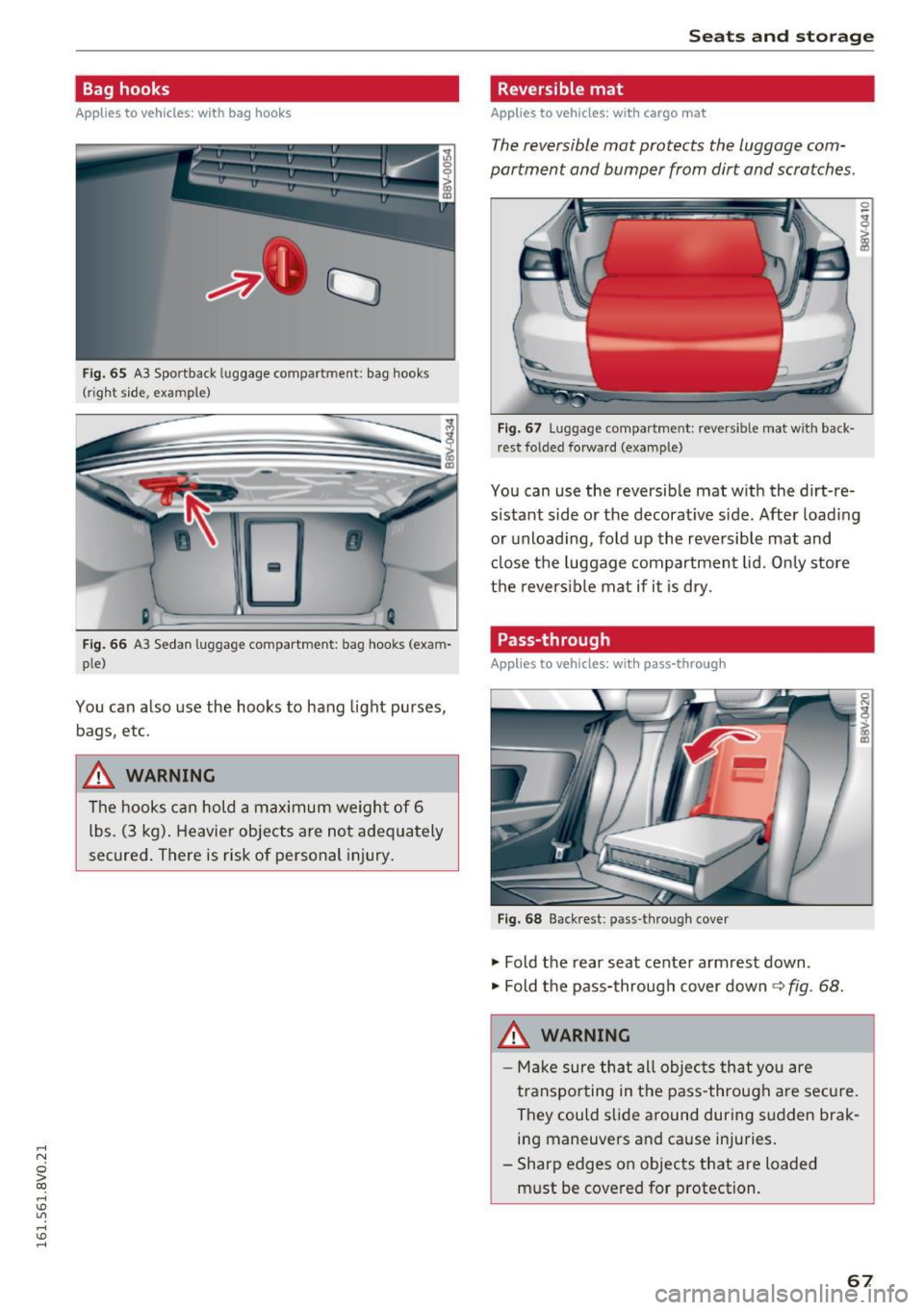
.... N
0 > CX)
rl I.Cl U"I
rl I.Cl ....
Bag hooks
Applies to vehicles: with bag hooks
Fig. 65 A3 Sportba ck luggage com part men t: bag hook s
( r igh t sid e, e xampl e)
Fig. 66 A3 Sed an luggag e compartmen t: bag hoo ks (exa m
p le )
You can also use the hooks to hang light purses ,
bags , etc.
_&. WARNING
The hooks can hold a maximum weight of 6
lbs. (3 kg). Heavier objects are not adequately
secured. There is risk of personal injury.
Seats and storage
Reversible mat
Applies to vehicles: with cargo mat
The reversible mat protects the luggage com
partment and bumper from dirt and scratches.
Fig. 67 Lugg ag e compar tment: re ve rs ib le ma t w it h back
rest folded forward (example)
You can use the reversible mat with the dirt-re
sistant side or the decorative side. After loading
or unloading, fold up the reversible mat and
close the luggage compartment lid. Only store
the reversible mat if it is dry.
Pass-through
Appl ies to vehicles: with pass-through
Fig. 68 Backrest: pass -thro ugh cover
.,. Fold the rear seat center armrest down .
.,. Fold the pass-through cover down¢
fig. 68.
_&. WARNING
- Make sure that all objects that you are
transporting in the pass-through are secure.
They could slide around during sudden brak ing maneuvers and cause injuries .
- Sharp edges on objects that are loaded must be covered for protection.
67
Page 71 of 328

,....,
N
0 > co ,....,
Always distribute loads evenly. Make sure any
thing on the roof rack is securely tied down .
11-Always distribute the loads on the roof rack
evenly .
11-Always attach items to the roof rack securely
before you drive off.
The maximum permiss ible roof weight is
165 lb
( 7 5 kg ). The roof weight is the total of the
weight of the roof rack, the attachments and the
cargo you are carrying. You must also not exceed
the maximum load weight fo r th e roof rac k you
are using.
When us ing a roof rack system wh ich has a lower
l oad carry ing capacity, you must not use up the
to ta l maximum permissible load car rying capaci
ty specified above. Instead, you s hou ld load the
r oof rack system only to the maximum capac ity
specified by the manufacturer of the roof rack
system .
A WARNING
Weak, damaged or improper straps used to
secure items to the roof rack can fa il during
hard braking or in a collision and cause seri
ous personal injury.
- Make sure the roof rack is installed exactly
as spec ified above
c> page 68.
- Always use su itab le mounting straps for se
curing items to the roof rack to help prevent
items from shifting or fly ing forward .
- Items on the roof rack must always be se
curely mounted.
- The use of a roof rack can negatively affect
the way a vehicle handles. Cargo that is
large, heavy, bulky, long or flat will have a
greate r negative influence on the vehicle's
aerodynamics, cente r of g ravity and ove rall
hand lin g. A lways d rive slowly, avoid sudden
bra king and mane uvers when transpo rting
cargo on the roof of you r vehicle .
- Never exceed the maxim um permissible
load carrying cap aci ty of the roof of you r ve
hicle, the permissib le ax le weigh ts and the
permissible total weight of your vehicle
c> page 301, Weights.
-
Seat s and sto rage
{® For the sake of the environment
As a result of the increased wind resistance
created by a roof rack, your vehicle is using
fuel unnecessarily. So remove the roof rack
after using it.
69
Page 129 of 328
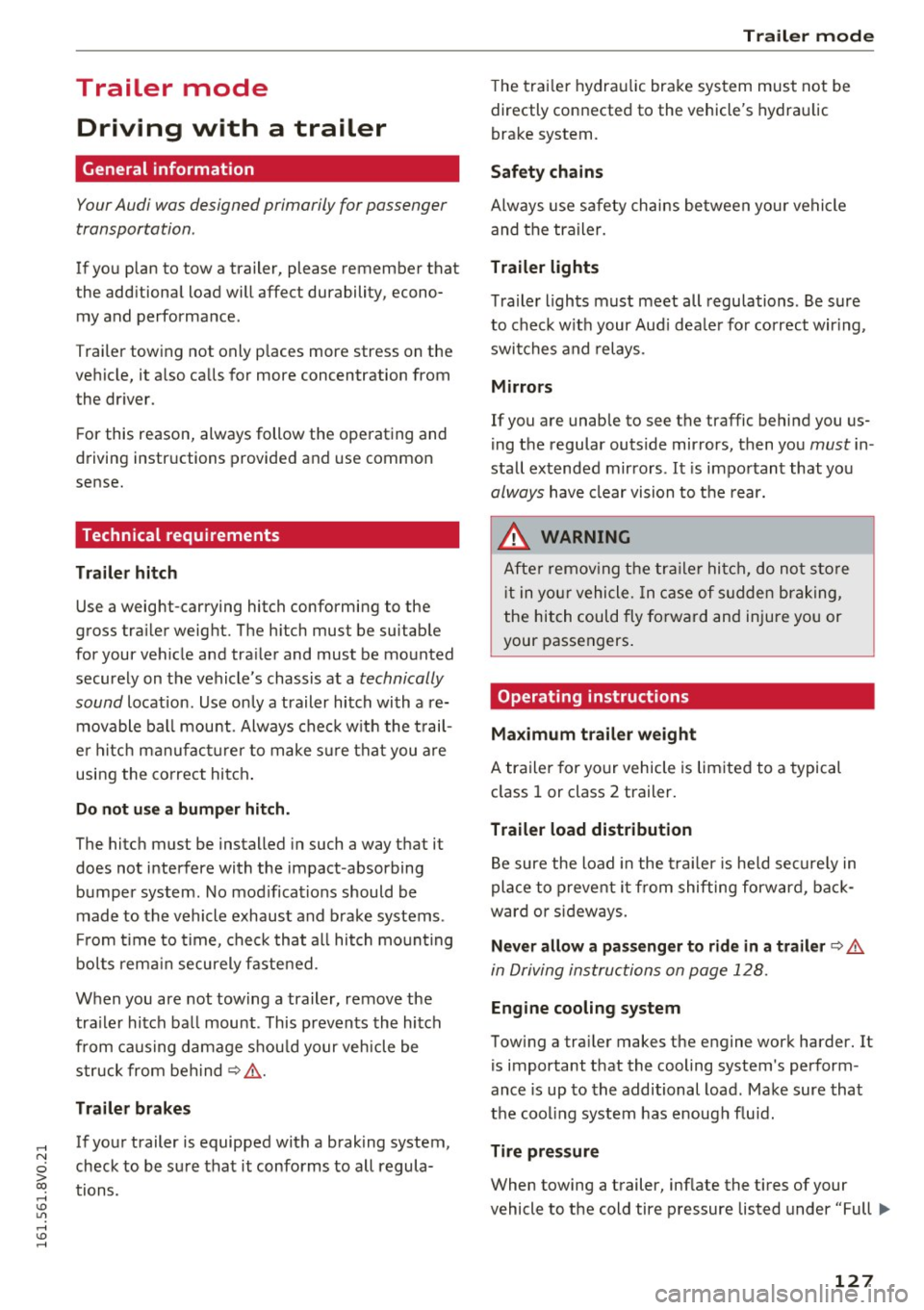
,....,
N
0 > co ,....,
General information
Your Audi was designed primarily for passenger
transportation .
If you plan to tow a trailer, please remember that
the additional load will affect durability, econo
my and performance.
T railer towing not only places more stress on the
vehicle, it also calls for more concentration from
the driver.
For this reason, always follow the operating and
driving instructions provided and use common
sense.
Technical requirements
Trailer hitch
Use a weight-carrying hitch conforming to the
gross trailer weight. The hitch must be suitable
for your vehicle and trailer and must be mounted
securely on the vehicle's chassis at a technically
sound
location . Use only a trailer hitch with a re
movable ball mount . Always check with the trail
er hitch manufacturer to make sure that you are
using the correct hitch.
Do not use a bumper hitch.
The hitch must be installed in such a way that it
does not interfere with the impact -absorbing
bumper system . No modifications should be
made to the vehicle exhaust and brake systems .
From time to time, check that all hitch mounting
bo lts remain securely fastened.
When you are not towing a trailer,
remove the
tra iler hitch ball mount . This prevents the hitch
from causing damage should your vehicle be
struck from beh ind
~ ,&. .
Trailer brakes
If your trailer is equipped with a braking system,
check to be sure that it conforms to all regula
tions .
Trailer mode
The trailer hydraulic brake system must not be
directly connected to the vehicle's hydraulic
brake system.
Safety chains
Always use safety chains between your vehicle
and the trailer.
Trailer lights
T ra iler lights must meet all regulations . Be sure
to check with your Aud i dea ler for correct wiring,
switches and relays .
Mirrors
If you are unable to see the traffic behind you us
ing the regular outside mirrors, then you
must in
stall extended mirrors . It is important that you
always have clear vision to the rear.
,8. WARNING
After removing the trailer hitch, do not store
it in your vehicle. In case of sudden braking,
the hitch could fly forward and injure you or
your passengers.
Operating instructions
Maximum trailer weight
A trailer for your vehicle is limited to a typical
class 1 or class 2 trailer.
Trailer load distribution Be sure the load in the trailer is held securely in
place to prevent it from shifting forward, back
ward or sideways.
Never allow a passenger to ride in a trailer~.&.
in Driving instructions on page 128.
Engine cooling system
Towing a trailer makes the engine work harder. It
is important that the cooling system's perform
ance is up to the additional load. Make sure that
the cooling system has enough fluid.
Tire pressure
When towing a trailer, inflate the tires of your
vehicle to the cold tire pressure listed under "Full ..,.
127
Page 130 of 328
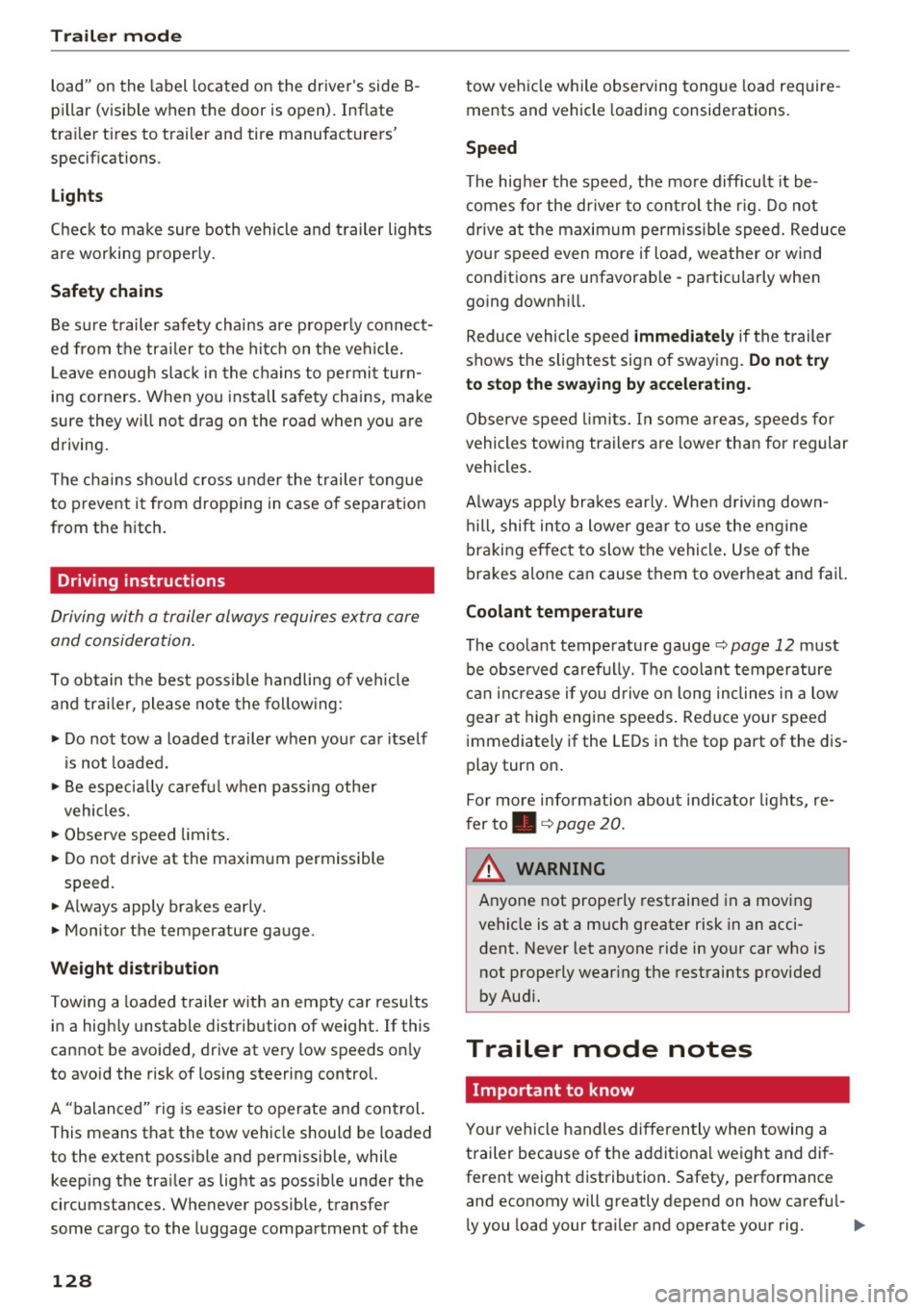
Trailer mod e
load" on the la bel located on the driver's side B
pillar (visib le when the door is open) . Inflate
tra iler tires to trailer and tire manufacturers'
specif ications.
Lights
Check to make sure both vehicle and t railer lights
are working p roper ly.
Safety chains
Be sure t railer safety chains are properly connect
ed from the trai le r to the hi tch on the veh icle.
L eave enough sla ck in the cha ins to permi t turn
ing corners. When yo u install safety chains, ma ke
sure they wi ll not drag on the road when yo u are
driving .
The cha ins s hou ld cross under the trailer tongue
t o prevent it from dropping in case of separation
from the h itch .
Driving instructions
Driving with a trailer always requires extra care
and consideration .
To obtain t he best poss ible handling of vehicle
and traile r, please note the fo llow ing :
.,. Do not tow a loaded trailer when your car itself
is not loaded.
.. Be especi ally ca ref ul when pass ing othe r
vehicles.
.. Observe speed limi ts .
.. Do not d rive at the maximum permissible
speed.
.. Always apply brakes early.
.. Monitor the temperature gauge .
Weight distribution
Towing a loaded t railer w ith an empty car res ults
in a high ly unstable distribution of weight . If this
cannot be avoided, drive at very low speeds on ly
to avoid the risk of losing steering control.
A "balanced" rig is easie r to operate and cont rol.
This means that the tow vehi cle should be loaded
to the extent possible and permissible, while
keep ing the tra iler as light as possib le under the
circumstances. Whenever possible, transfer
some cargo to the l uggage compartment of the
128
tow veh icle wh ile observing tong ue load require
ments and vehicle loading considerations.
Speed
The higher the speed, the mo re diff icu lt i t be
comes for the driver to con trol the r ig. Do not
drive at t he maxim um permissible speed. Reduce
you r speed even more if load, weather or wind
con dit ions are unfavorab le - partic ularly when
go ing downh ill.
Reduce vehicle speed
immediately if the trailer
shows the slightest sign of swaying.
Do not try
to stop the swaying by accelerating.
Observe speed limi ts. In some areas, s peeds fo r
vehicles towing trailers are lower than for regular
vehicles .
A lways apply bra kes early. Whe n driving down
hill, shift in to a lower gea r to use the engine
b raki ng effect to slow the vehi cle. Use of the
brakes alone ca n cause them to over heat and fai l.
Coolant temperature
The coolant temperature gauge 9 page 12 must
be obse rved caref ully. The coolant temperature
c a n incre ase if yo u drive o n long incl ines in a low
gear a t high engine speeds . Red uce your speed
immediately if the LE Ds in the top part of the dis
play turn on .
Fo r more info rm ation abou t indicator lights, re
fer to . ¢
page 20 .
A WARNING
-
Anyone not prope rly restrai ned in a moving
vehicle is at a much greate r risk in an acci
dent. Never let anyone ride in your car who is
not properly wear ing the restraints provided
by Aud i.
Trailer mode notes
Important to know
Your vehicle handles differen tly when towing a
trailer because o f the additiona l weight and di f
ferent weight distribution. Safety, performance
and economy will g reatly depend on how caref ul-
l y you load your trai ler and operate you r rig. ..,_
Page 174 of 328
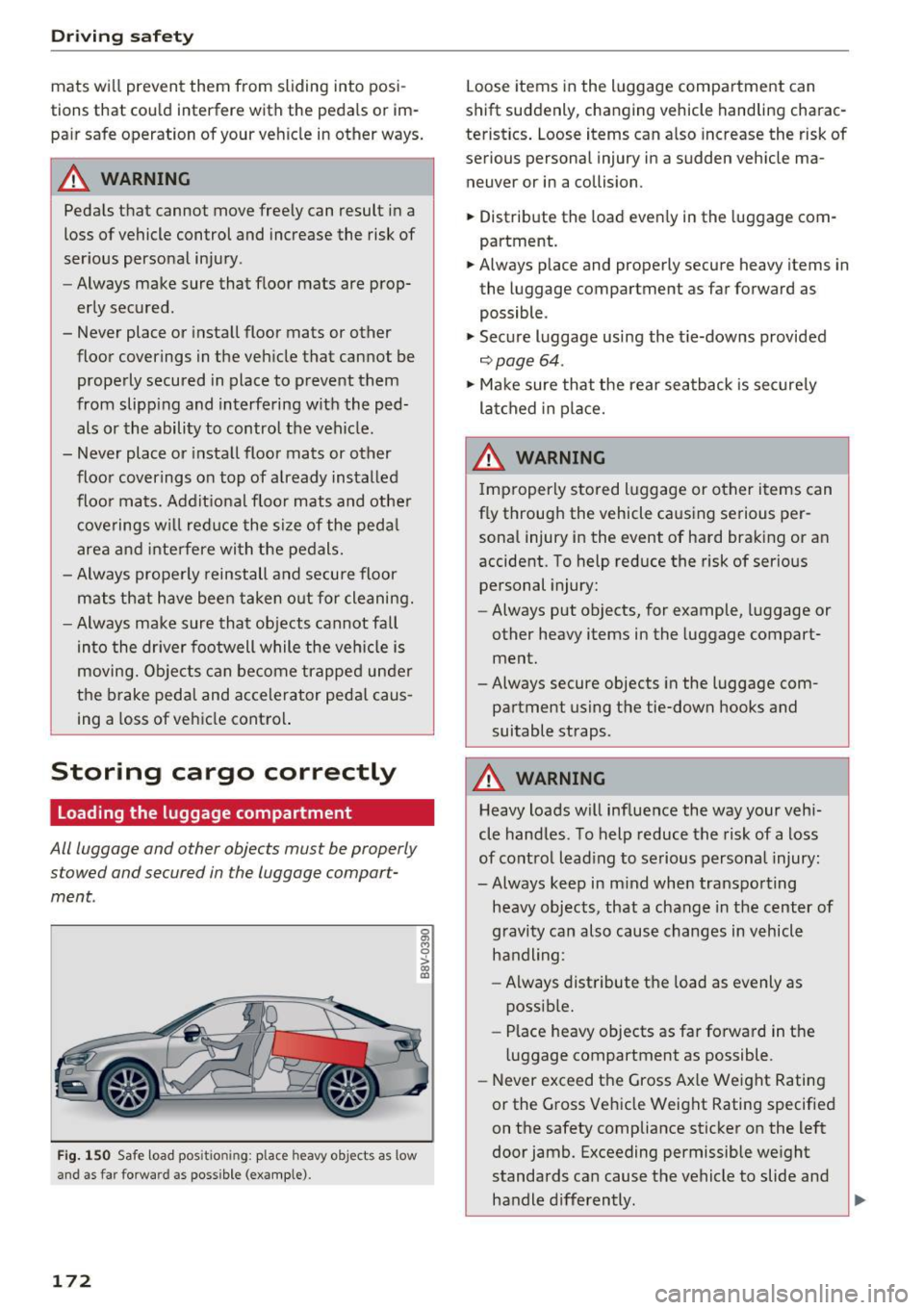
Driving safety
mats will prevent them from sliding into posi
tions that could interfere with the pedals or im
pair safe operation of your vehicle in other ways.
A WARNING
Pedals that cannot move freely can result in a
loss of vehicle control and increase the risk of
serious personal injury.
- Always make sure that floor mats are prop
erly secured .
- Never place or install floor mats or other
floor coverings in the vehicle that cannot be
properly secured in place to prevent them
from slipping and interfering with the ped als or the ability to control the vehicle.
- Never place or install floor mats or other
floor coverings on top of already installed
floor mats. Addit ional floor mats and other
coverings will reduce the size of the pedal
area and interfere with the pedals.
- Always properly reinstall and secure floor
mats that have been taken out for cleaning.
- Always make sure that objects cannot fall
into the driver footwell while the veh icle is
moving. Objects can become trapped under
the brake pedal and accelerator pedal caus
ing a loss of vehicle control.
Storing cargo correctly
Loading the luggage compartment
All luggage and other objects must be properly
s towed and secured in the luggage compart
ment.
Fig. 150 Safe load pos it io nin g: place heavy objects as low
and as far forward as possible (example) .
172
Loose items in the luggage compartment can
shift suddenly, changing vehicle handling charac
teristics. Loose items can also increase the risk of
serious personal injury in a sudden vehicle ma
neuver or in a collision.
.,. Distribute the load evenly in the luggage com
partment.
.,. Always place and properly secure heavy items in
the luggage compartment as far forward as
possible .
.,. Secure luggage using the t ie-downs provided
~ page 64.
.,. Make sure that the rear seatback is securely
latched in place.
A WARNING
Improperly stored luggage or other items can
fly through the vehicle causing serious per sonal injury in the event of hard braking or an
accident. To help reduce the risk of serious personal injury:
- Always put objects, for example, luggage or
other heavy items in the luggage compart
ment.
-Always secure objects in the luggage com
partment using the tie-down hooks and
suitable straps .
A WARNING
Heavy loads will influence the way your vehi
cle handles . To help reduce the risk of a loss
of control leading to serious personal injury:
-Always keep in mind when transporting heavy objects, that a change in the center of
gravity can also cause changes in vehicle
handling:
- Always distribute the load as evenly as
possible.
- Place heavy objects as far forward in the
luggage compartment as possible .
- Never exceed the Gross Axle Weight Rating
or the Gross Vehicle Weight Rating specified
on the safety compliance sticker on the left
door jamb. Exceeding permissible weight
standards can cause the vehicle to slide and
handle differently .
Ill>-
Page 175 of 328
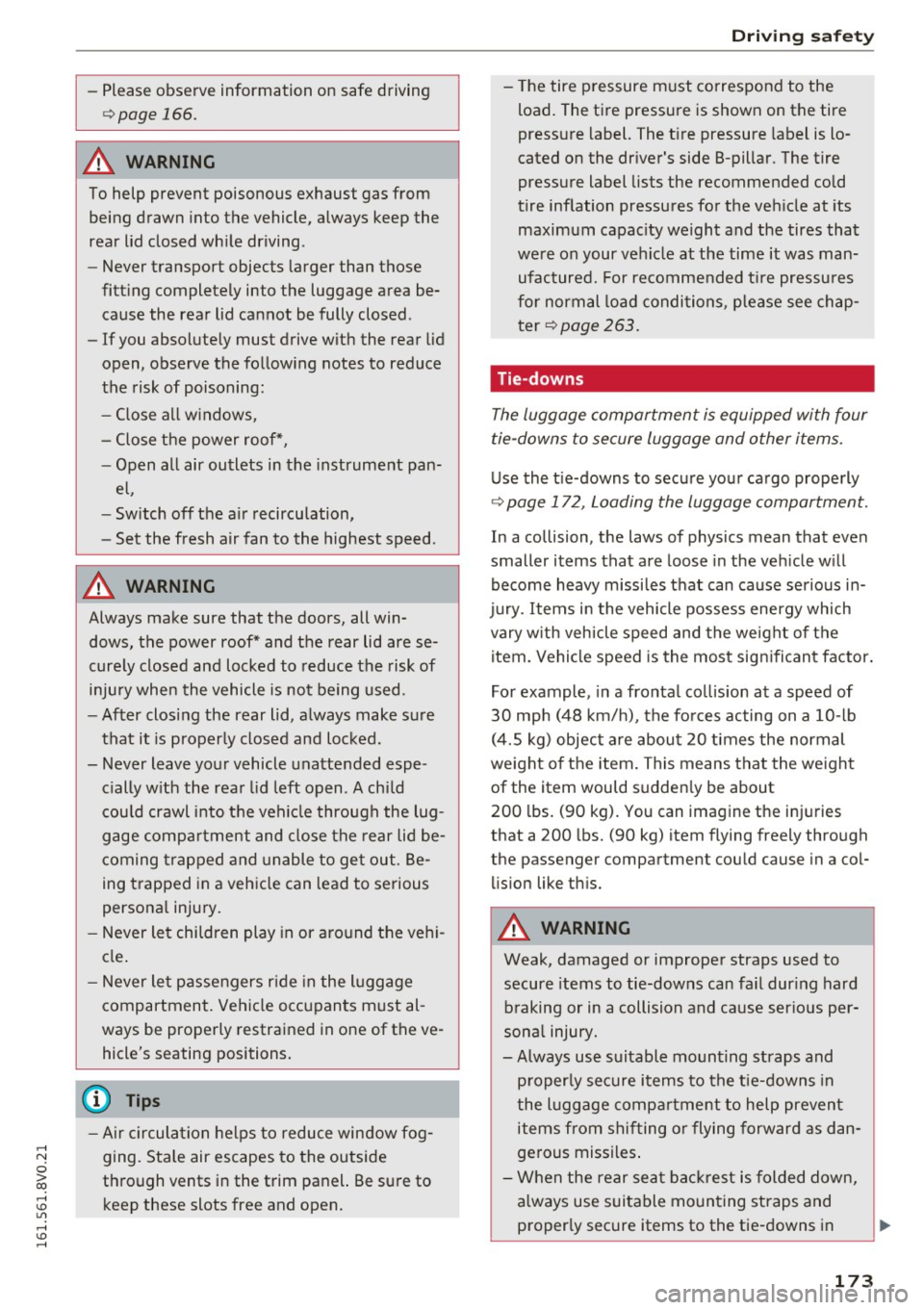
.... N
0 > co ....
~page 166.
A WARNING
To help prevent poisonous exhaust gas from
being drawn into the vehicle, always keep the
rear lid closed while driving .
- Never transport objects larger than those
fitting completely into the luggage area be
cause the rear lid cannot be fully closed .
-If you absolutely must drive with the rear lid
open, observe the following notes to reduce
the risk of poisoning:
- Close all w indows,
- Close the power roof*,
- Open all air outlets in the instrument pan-
el,
- Switch off the air recirculation,
- Set the fresh air fan to the highest speed .
A WARNING
-
Always make sure that the doors, all win
dows, the power roof* and the rear lid are se
curely closed and locked to reduce the risk of
injury when the vehicle is not being used.
- After closing the rear lid, always make sure
that it is properly closed and locked.
- Never leave your vehicle unattended espe
cially with the rear lid left open. A child
could crawl into the vehicle through the lug
gage compartment and close the rear lid be
coming trapped and unable to get out. Be
ing trapped in a vehicle can lead to serious
personal injury.
- Never let children play in or around the vehi
cle.
- Never let passengers r ide in the luggage
compartment. Vehicle occupants must al
ways be properly restrained in one of the ve
hicle's seating positions.
(D Tips
- Air circulation helps to reduce window fog
ging. Stale air escapes to the outside
through vents in the trim panel. Be sure to
keep these slots free and open.
Driving safety
-The tire pressure must correspond to the
load. The tire pressure is shown on the tire
pressure label. The tire pressure label is lo
cated on the driver's side B-pillar . The tire
pressure label lists the recommended cold
tire inflation pressures for the vehicle at its
maximum capacity weight and the tires that
were on your vehicle at the time it was man ufactured. For recommended tire pressures
for normal load conditions, please see chap
ter
~ page 263.
' Tie-downs
The luggage compartment is equipped with four
tie-downs to secure luggage and other items.
Use the tie-downs to secure your cargo properly
~ page 172, Loading the luggage compartment.
In a collision, the laws of physics mean that even
smaller items that are loose in the vehicle will
become heavy missiles that can cause serious in
jury. Items in the vehicle possess energy which
vary w ith vehicle speed and the weight of the
item. Vehicle speed is the most significant factor.
For example, in a frontal collision at a speed of
30 mph (48 km/h), the forces acting on a 10-lb
(4.5 kg) object are about 20 times the normal
weight of the item. This means that the weight
of the item would sudden ly be about
200 lbs. (90 kg). You can imagine the injuries
that a 200 lbs. (90 kg) item flying freely through
the passenger compartment could cause in a col
lision like th is.
A WARNING
-Weak, damaged or improper straps used to
secure items to tie-downs can fail dur ing hard
braking or in a collision and cause serious per
sona l injury.
- Always use suitable mounting straps and
properly secure items to the tie-downs in
the luggage compartment to help prevent
items from shifting or flying forward as dan
gerous missiles .
- When the rear seat backrest is folded down,
always use suitable mounting straps and
properly secure items to the tie-downs in
173
Page 179 of 328
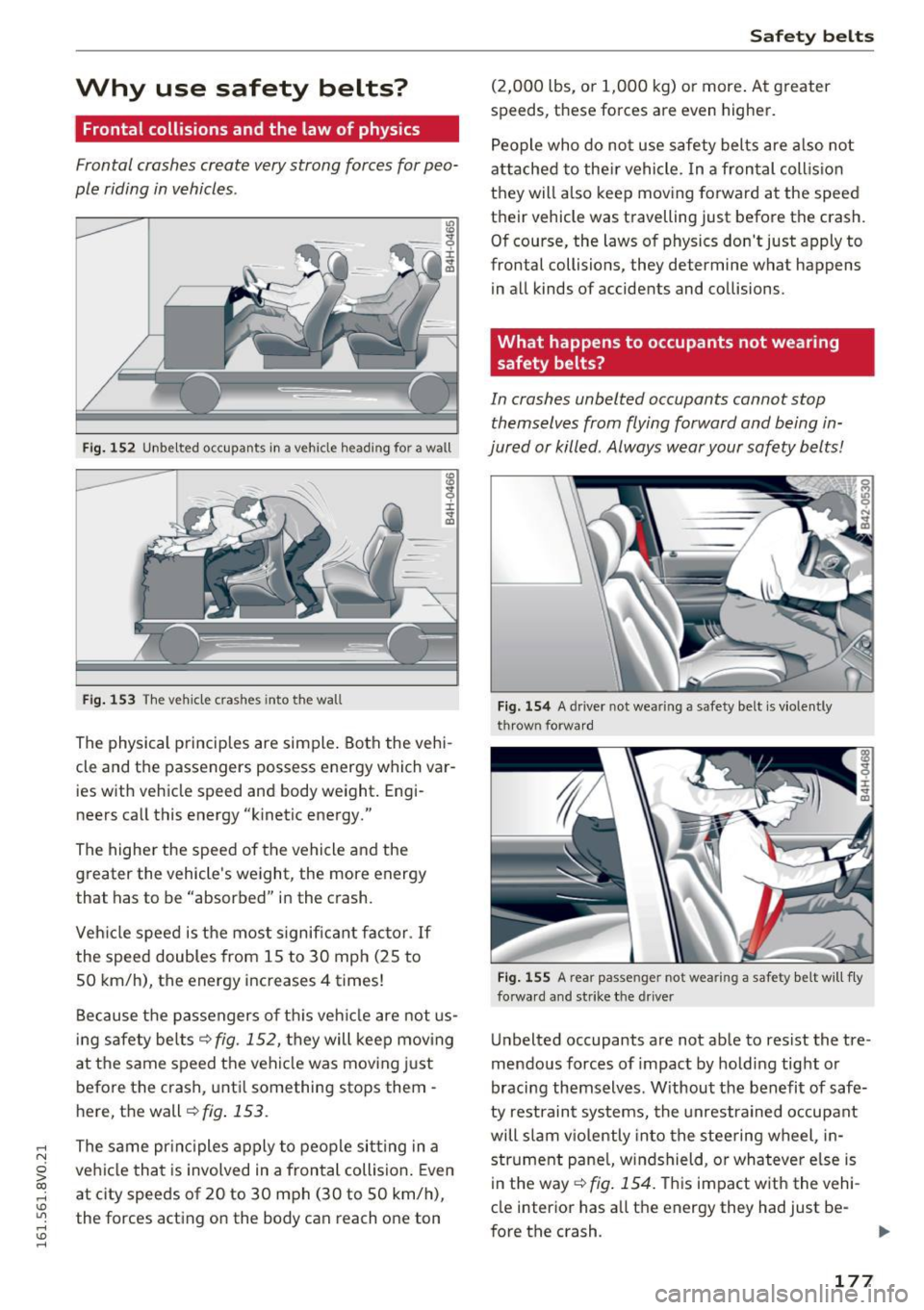
.... N
0 > CX)
.... I.Cl U"I
.... I.Cl ....
Why use safety belts?
Frontal collisions and the law of physics
Frontal crashes create very strong forces for peo
ple riding in vehicles .
Fig. 152 Unbelted occupants in a vehicle heading for a wall
Fig . 153 The vehicle crashes into the wall
CD
~ ±
cle and the passengers possess energy which var
ies with vehicle speed and body weight. Engi
neers call this energy "kinetic energy."
The higher the speed of the vehicle and the
greater the vehicle's weight, the more energy
that has to be "absorbed" in the crash.
Veh icle speed is the most significant factor.
If
the speed doubles from 15 to 30 mph (25 to
50 km/h), the energy increases 4 times!
Because the passengers of this vehicle are not us
ing safety belts¢
fig. 152, they will keep mov ing
at the same speed the vehicle was moving just
before the crash, until something stops them -
here, the wall
¢fig. 153.
The same principles apply to people sitting in a
vehicle that is involved in a frontal collision . Even
at city speeds of 20 to 30 mph (30 to 50 km/h),
the forces acting on the body can reach one ton
Safety belts
(2,000 lbs, o r 1,000 kg) or more . At greater
speeds, these forces are even higher.
People who do not use safety belts are also not
attached to their vehicle. In a frontal collision
they will also keep moving forward at the speed
their vehicle was travelling just before the crash.
Of course, the laws of physics don't just apply to
frontal collisions, they determine what happens in all kinds of accidents and co llisions.
What happens to occupants not wearing
safety belts?
In crashes unbelted occupants cannot stop
themselves from flying forward and being in
jured or killed . Always wear your safety belts!
Fig. 154 A driver not wearing a safety belt is v iolently
thrown forward
Fig. 155 A rear passenger not wearing a safety belt will fly
forwa rd and strike the
driver
Unbelted occupants are not able to resist the tre
mendous forces of impact by hold ing tig ht or
bracing themselves . Without the benefit of safe
ty restraint systems, the unrestrained occupant
will slam viol ently into the steering wheel, in
strument panel, windshield, or whatever e lse is
i n the way
¢fi g. 154. This impact w ith the vehi
cle interior has all the energy they had just be-
fore the crash.
Ill>-
177
Page 188 of 328
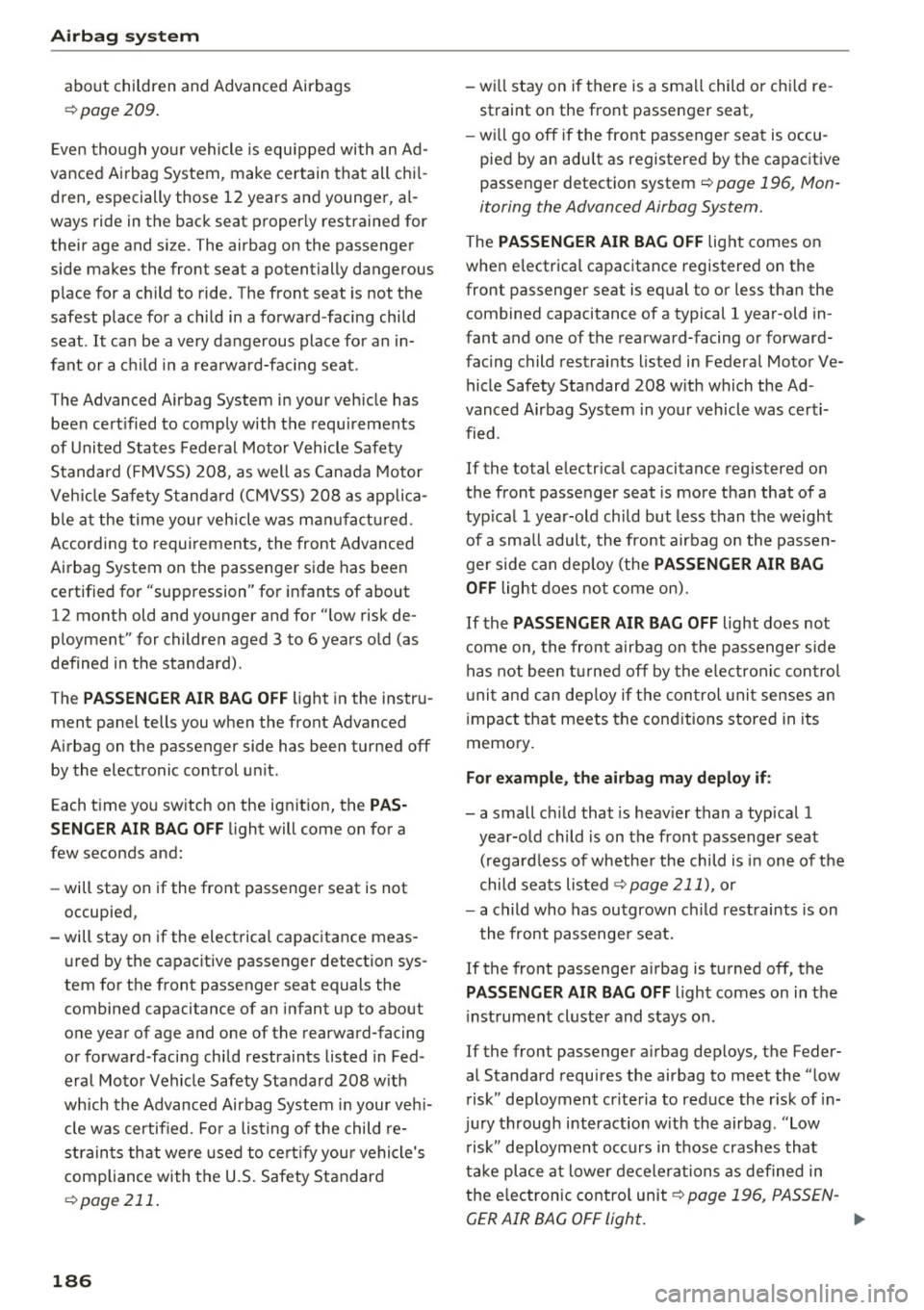
Airbag syste m
about children and Advanced Airbags
¢page 209 .
Even tho ugh your vehicle is equipped with an Ad
vanced Airbag System, make certain that all chi l
dren, especially those 12 years and younger, al
ways ride in the back seat proper ly restrained for
their age and size. The airbag on the passenger
side makes the front seat a potentially dangerous place for a child to ride. The front seat is not the
safest place for a child in a forward-facing child
seat . It ca n be a very dangerous place for an in
fant or a c hild in a rearward-fac ing seat.
The Advanced Airbag System in your veh icle has
been cert ified to comply with the requirements
of United States Federal Motor Vehicle Safety
Standard ( FMVSS) 208, as well as Canada Motor
Veh icle Safety Standa rd (CMVSS) 208 as applica
b le at the time your vehicle was man ufa ct ur ed.
According to requi rements, the front Advanced
Airbag System on the passenger side has been
certified for "suppression" for infants of about 12 month old and younger and for "low risk de
ployment" for children aged 3 to 6 years o ld (as
defined in the standard) .
The
PAS SENGER AIR BAG O FF light in the instru
ment panel tells you when the front Advanced
Airbag on the passenger side has been turned off by the electronic control unit.
Each time you switch on the ignition, the
PAS
S ENGER AIR BAG OFF
light will come on for a
few seconds and:
- will stay on if the front passenger seat is not
occupied,
- will stay on if the electrical capacitance meas
ured by the capacitive passenger detection sys
tem for the front passenger seat equals the
combined capacitance of an infant up to about one year of age and one of the rearward-facing
or forward-facing child restraints listed in Fed
eral Motor Vehicle Safety Standard 208 w ith
which the Advanced Airbag System in your veh i
cle was certified. Fo r a listing of the child re
straints that were used to cert ify your vehicle's
compliance with the U.S. Safety Standard
¢ page 211 .
186
- will stay on if there is a sma ll child o r chi ld re
straint on the front passenger seat,
- wi ll go off if the front passenger seat is occu
pied by an adult as registered by the capacitive
passenger detectio n system ~
page 196, Mon
itoring the Advanced Airbag System.
The PAS SENGER AIR BAG OFF lig ht comes on
when electrical capacitance registered on the
front passenger seat is equal to or less than the
combined capacitance of a typical 1 year-old in
fant and one of the rearward-facing or forward
facing child restraints listed in Federal Motor Ve hicle Safety Standard 208 w ith which the Ad
vanced Airbag System in your vehicle was certi
fied .
If the total electr ical capacitance registered o n
the front passenger seat is more than that of a
typ ical 1 year-old chi ld but less than the weight
of a sma ll adult, the front airbag on the passen
ger side can deploy (the
PAS SENGER AIR BAG
OFF
light does not come on).
If the
PASSENGER AIR BAG OFF light does not
come on, the front airbag on the passenger side
has not been t urned off by the electron ic con trol
u nit and can dep loy if the con trol uni t senses an
impact t hat meets the conditions stored in its
memo ry.
For exampl e, the airbag ma y depl oy if:
- a small ch ild that is heav ier than a typ ical 1
year-old child is on the front passenger seat (regard less of whethe r the child is in one of the
child seats listed ¢
page 211), or
- a child who has outgrown ch ild restraints is on
the front passenge r seat.
If the front passenger a irbag is turned off, the
PA SSENGER AIR BAG OFF light comes on in the
i nst rument cluster and stays on .
If the front passenger airbag deploys, the Feder
al Standard requires the airbag to meet the "low
risk" dep loyment criteria to reduce the r isk of in
ju ry through interaction w ith the airbag . "Low
r isk" dep loyment occurs in those crashes that
take place at lower decelerations as defined in
the e lectronic contro l unit ¢
page 196, PASSEN-
GER AIR BAG OFF light. .,_
Page 192 of 328

Airbag syste m
restrained, not just because the law requires you
to be.
The Advanced Airbag System in your veh icle has
been cert ified to meet the "low r isk" require
ments for 3 and 6 year-o ld children on the pas
senger side and very sma ll adults on the driver
side . The low risk dep loyment cr iteria are intend
ed to he lp reduce the risk of injury through inter
action with the front airbag that can occur, for
example, by being too close to the steering wheel
a nd instrument panel when the airbag inflates .
In addition, the system has been certified to
comply w ith the "suppression" requirements of
the Safety Standard, to turn off the front a irbag
for i nfants 12 months old and younger who a re
restrained on the front passenger seat in ch ild re
stra ints that are listed in the Standa rd
¢ page 211, Child restraints and Advanced front
airbag system.
" Suppression" requ ires the front a irbag on the
passenger side to be tu rned off if:
- a child up to about one year of age is restra ined
o n the fro nt passenger seat in one of the rear
facing or forward-facing infant restraints listed
in Federal Motor Vehicle Safety Standard 208
with wh ich the Advanced Airbag System in your
vehicle was certified. For a listing of the ch ild
restraints that were used to certify your vehi
cle's compliance with the US Safety Standard
¢ page 211,
-When a person is detected on the front passen
ger seat that has an electrica l capacitance t hat
is more than the tota l electrical capacitance of
a chi ld that is about 1 year old restrained in one
of the rear-facing or forward-fac ing infant re
straints (listed in Federal Motor Vehicle Safety
Standard 208 w ith w hich the Advanced A irbag
System in your veh icle was certified), the front
airbag on the passenge r side may or may not
deploy.
The
P ASS ENGER AIR BAG OFF light comes on
when the e lectron ic cont rol un it detects a total
e lectr ica l capacitance on the front passenger seat
that requires the front a irbag to be turned off. If
the
PAS SENGER AIR BAG OFF light does not
come on, the front airbag on the passenger side
190
has not been turned off by the contro l uni t and
can deploy if the contro l unit senses an impact
that meets the cond itions stored in its memory.
If the total e lectr ica l capacitance registered o n
the front passenger seat is more than that of a
typica l 1 year-old, but less than the weight of a
small adu lt, t he front a irbag on the passenger
s ide may deploy (the
PA SS ENGER AIR BAG OFF
light does not come on).
For e xample , the ai rbag ma y deplo y if:
- a small ch ild that is heav ier than a typica l 1
year-old child is on the front passenger seat
(regard less o f whether the child is in one o f the
child seats listed
¢ page 211),
-a child who has outgrown child restraints is on
the front passenger seat.
If the front passenger a irbag is t urned off, the
PA SSENGER AIR BAG O FF light in the center of
the instr ument pane l will come on and stay on .
If the front passenger a irbag deploys, the Feder
al Standard requ ires the airbag to meet the "low
r isk" dep loyment criteria to he lp reduce the r isk
of inju ry through interaction with the airbag .
"Low risk" deployment occurs in those crashes
that take p lace at lower decelerations as defined
in the electronic contro l unit ¢
page 196.
Alwa ys remembe r: Even though your vehicle is
equipped with Advanced Airbags, the safest place
for children is properly restrained on the back
seat. Please be sure to read the important infor
mation in the sections that fo llow and be sure to
heed all of the WARNINGS.
A WARNING
To reduce the risk of injury when an airbag in
flates, always wea r safety belts prope rly.
- If you are unrestrained, leaning forward, sit
ting sideways or out of position in any way,
your r isk of injury is much highe r.
- You will also receive ser ious injuries and
could even be killed if you are up against the
airbag or too close to it when i t inflates -
even with an Advanced Airbag
¢page 184.